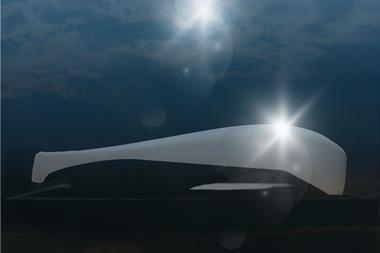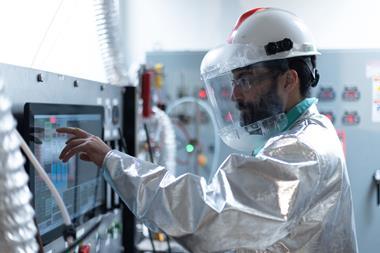 Mark White, Chief Technical Specialist, Body Engineering, Jaguar Land Rover Cars, talks about why riveting is the OEM's first-choice joining method
Mark White, Chief Technical Specialist, Body Engineering, Jaguar Land Rover Cars, talks about why riveting is the OEM's first-choice joining method
The body construction history of both Jaguar and Land Rover vehicles makes for a fascinating backdrop to the current trend towards the lightweight BIW. At Jaguar, with its origins in motorcycle sidecars and lightweight saloons, sports cars and racing, combined monocoque/spaceframe and aluminium usage has been an integral part of its cars ‘DNA’. And at Land Rover, with its use of aluminium for the outer body of the first Land Rover in 1948, spaceframe and mixed-metal construction in all later models, an ‘openminded’ policy on material usage is in the brand’s core make-up.
Bringing this heritage up-to-date and using it to help change the image of luxury cars and SUVs from heavy and high-polluting to green and efficient is a complex task. Mark White relishes the challenge and while constantly looking for innovative body construction processes and technologies, he always has the carbon footprint of JLR products on his mind, as he tells us.
AMS: Can you tell us about the trends at Jaguar with regards to aluminium bonding and joining? Are you favouring
nonweld systems, such as riveting and adhesive bonding?
Mark White: I think that rather than following a rigid plan developed over the last 15 years, we have evolved organically to where we are today. When we were doing the development of the XJ, we looked seriously at spot welding the car, but with the historic information we had on aluminium spot welding, from Jaguar under Ford and from Land Rover, we knew that there were some significant issues that needed addressing- not least tip dressing. These had to be overcome for high volume production.
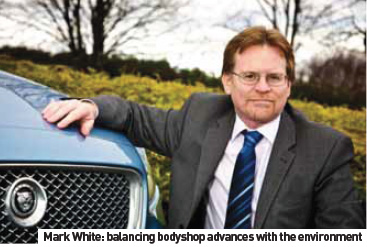
For instance, you can manually tip dress on relatively low volumes once every 10 welds but doing that in an automated welding shop is quite a challenge. We have actually come up with systems that overcome that problem, but that complexity and other things really pushed us towards looking at self-pierce rivets (SPR). When we looked at the SPR process, we found that we needed a lot less rivets than spot welds. If an average large F-segment vehicle, be it a saloon or an SUV, has between five and 6,000 spot welds, we found that we needed only about 3,000 rivets. So, although the rivets are more expensive, as you are actually buying a bag of rivets (and you don’t buy a bag of spot welds), the robustness of the rivet process and the fact that you need a lot less of them, looked attractive to us. Then when we started to look at the infrastructure for a new plant in terms of air extraction, cooling water, compressed air for robots and guns, we actually found out we needed a lot less infrastructure for the SPRs than we did for aluminium spot welding. It worked out that we were not only getting a more robust joint, we were getting a ‘cleaner’ joint – the riveting process had a significantly lower carbon footprint than the welding process.
At the time, no one else was using SPR technology in any real volume, and so we worked with Henrob to pioneer the guns and the rivets, and together we are now amongst the leaders if not the global leaders in the use of the technology. AMS: Land Rover was a pioneer of aluminium usage in body construction, going back to the first vehicles in 1948, and this has now really come into fashion.
MW: Yes, absolutely. When one introduces new technology to a company, you don’t always get the manufacturing guys congratulating you, often the reverse. With the SPR technology, the JLR team are at least as big a fan of it as I am. Riveting is definitely a win-win situation; a great product from a production development point of view and from a manufacturing aspect too.
AMS: With riveting, how do you specify the rivet material, including when joining similar metals and also dissimilar metals?
MW: There are different types of rivet. The main differences are in the grades of hardness, each suited to a different type of joint. If you were joining a high-strength steel part to an aluminium part then you would probably use a harder rivet type with a higher insertion pressure than you might with an all-aluminium application. Generally, if you buy rivets from Tucker, Böllhoff or Henrob, they should all fit into the same gun and the rivets should be completely interchangeable between the rivet guns. This is one major industry achievement; we do not have a problem if we are using Henrob rivets in one shop and Tucker in another, we don’t have a problem if we want to swap out a robot or a gun from one place to another.
We have made it a pre-condition of any quotation for rivet systems that a standard industry specification was adhered 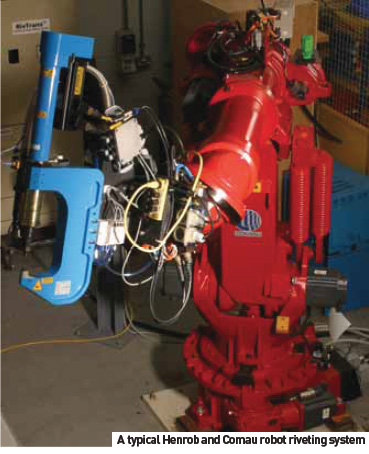 to,regardless of who won the contract.
to,regardless of who won the contract.
AMS: That will be very useful when manufacturing in other regions?
MW: Yes, if we want to install a line elsewhere, we want to be able to buy equipment off the shelf, so it is important to lay down these standards and have a high level of standardisation in the process.
AMS: How has the procurement process worked with finding riveting equipment suppliers? Are you still on the lookout for new partners and new technologies? MW: We are quite open to new rivet equipment suppliers. We have used Henrob to date, but we will be using other riveting systems makers, in the near future.
AMS: With the rivet application equipment, do you look for a whole package or buy equipment per application etc?
MW: We generally work with a line builder, like Steelweld, Thyssen or Comau on this. They will then work with whoever our selected rivet system supplier is. We want the ability to hang a Henrob gun on an ABB or Kawasaki robot, or indeed any other standard robot. We would source the rivet guns and indeed the rivets, at the same time as or even before choosing a line builder partner.
We choose the rivet system maker every time. We generally have more experience of rivet systems than the integrator and sometimes we find that they have not installed a rivet line before.
AMS: Threaded fasteners – do you prefer to press these in or use weld studs, etc?
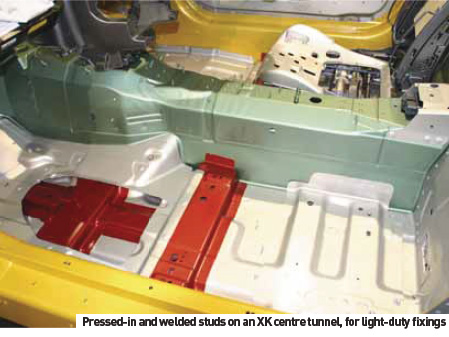
MW: We have a variety of fastener methods, though I would say our strategy here is still under development. We are now on our third aluminium car; we are looking at all kinds of fastener technology, with robustness being our primary requirement, plus the cost of each joint. I still like weldstuds, but they are only really good for low-torque applications. An aluminium weldstud onto an aluminium part will not have anything like the same strength as a steelto- steel assembly and would be suited to a low torque trim fastening application, where we might put a push-on plastic fastener onto the stud for holding a wiring harnesses, sound deadening or other lightweight trim material. Weldstuds are also used for earthing points around the car.
AMS: In-press stud fixings – are you a fan?
MW: We have a lot of experience using this in steel. We are actively looking at this for aluminium applications and we will be using it in the future.
AMS: In high-strength steel applications, is it better to use a mechanically-fixed fastener rather than a welded one, in order to avoid compromising the strength qualities of the steel in that area?
MW: We use both methods, though we do not have a firm policy on this. The choice would depend on whether the joint was in a corrosion-prone environment or a safety– critical fixing, such as a seatbelt anchorage.
AMS: How do you train personnel for riveting, are there special requirements or skill sets?
MW: In the past, we have worked very closely with supplier partners on training our people, now we have enough internal expertise in riveting that we can handle our own training.
AMS: How do you choose a rivet system partner?
MW: We select a rivet system supplier for many qualities; we do not just order as a commodity, we want a partner who will work with us on developing the robustness of say, a rivet gun. When we first installed Henrob guns, we had some issues with using them in a fully automated scenario. There was no inherent problem with the equipment, but most of the guns had been used for relatively low-volume applications. When we put them on the end of a robot and install 20,000 rivets, this was quite a different demand.
AMS: What are the special requirements of the clinching processes using aluminium over steel?
MW: We generally use spot clinching for closures and for relatively low-strength applications. One of the drawbacks with the toggle-lock type joint is that in aluminium applications, it can ‘fret’ over time and effectively come loose. I like them, as they are such good value – no additional material, rivet, weld, etc., is used - but in terms of long-term durability I would not use them in a high-load application. We have clinched aluminium onto steel, and onto composites. Another element in multi-material clinching is electrolytic corrosion and here I firmly favour SPR for applications like bonnet hinge reinforcements and latch reinforcements.
AMS: How automated can you get with clinching operations like fitting door skins, etc?
MW: We are fully automated in clinching and roller hemming and we always think in high volume terms. We expect to start off a line as fully automated. Even set up and try out of a door skin roller hemming process would be modelled virtually with RobCad simulation, using the actual panel geometry. We then programme the robot from the RobCad, using the CAD geometry. We then set up the whole cell and ‘dry cycle’ it with the work in place, to make sure the RobCad programme and the off-line programming works as it should.
AMS: Do you have any favourite software packages for body assembly, including simulation solutions from companies like ESI, Delmia, Technomatix from Siemens and the CATIA platform?
MW: The choice of package is often worked out with the line builder or integrator. We know what we want in terms of specification, so we work with the line builder in terms of which package they use already. We use CATIA V5 for the base CAD information and, providing the line builder takes that, what they use for RobCad or factory simulation is generally left up to them, as long as it interfaces with the CATIA data.
AMS: Can you see fully pre-painted panels being clinched, as paint technology improves and clinching tech also improves?
MW: As we move towards the low-carbon factory, we have to consider the total energy equation. We don’t want to move the carbon footprint of the paint operation from our paintshop to a supplier by buying-in more ready-painted parts that we can hem onto a body structure. We have to take a holistic view of each part of the car, from its manufacture to the final fitting. Suppliers may not always have the kind of good environmental management that a carmaker has in place.
AMS: Is roller hemming as effective with the mixed materials you are using – hemming aluminium on to steel or magnesium frames, etc?
MW: Depending on the application, we will either use electro-coating or some type of passivation process between the two materials. If it is a steel/aluminium joint that is not exposed to corrosion, we might use a heavy zinc coating. If it were magnesium to aluminium, we would probably use powder coating or perhaps Keronite. We have not used Keronite in production yet, but in a high-corrosion situation, it may well be a good solution.
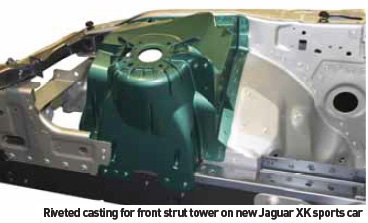 AMS: Will magnesium sheet or thin magnesium castings take over some existing aluminium applications, such as wings, fenders, roof panels, as magnesium comes down in price?
AMS: Will magnesium sheet or thin magnesium castings take over some existing aluminium applications, such as wings, fenders, roof panels, as magnesium comes down in price?
MW: We already use magnesium for almost all our crosscar beams and for most of our front end carriers, holding the radiator pack, headlights, etc., because it is a very light material, it gives us good part integration and we can protect it from corrosion using passivation technology.
However, magnesium still does have some drawbacks. If you want to join it to other materials, you have to isolate it and you are restricted to bolting it together rather than welding or riveting. It is coming down in price, but it is still prohibitively expensive, particularly in sheet form. We are working on some more inert magnesium alloys that will not need quite so much passivation or other anti-corrosion treatment.
Land Rover is building on the success of Profi l’s pierce fastening methods in its Discovery, Range Rover Sport, Freelander and Defender ranges by specifying a further 185 of the company’s clinch nuts and studs in the assembly of its all-new Evoque models.
A key feature of the Evoque is the extensive use of high strength (600-800 MPa) steel panels at the rear of the vehicle and in safetycritical impact areas around door apertures. “In addition to ensuring secure door hinge and seat anchorages in this material, Profi l pierce fasteners provide a variety of high strength, vibration-resistant mountings in areas such as the gear change console, front bulkhead and cross members,” notes Profi l’s UK Sales Manager, Adrian Ellis. “Thanks to our fasteners’ clinching action, Land Rover has been able to specify standard type RND nuts throughout the vehicle - even in 2 mm thick 600 MPa panels at the base of the A-pillar. This is a major advantage over normal welded nuts and studs, which are extremely diffi cult to secure to this material consistently.”
Additional benefi ts offered by Profi l fasteners include their ability to accommodate panel thicknesses from 0.6 to 4.0mm thick. They are equally suitable for use with coated or uncoated materials, high tensile, stainless and sandwich steels, and can even be installed in aluminium and magnesium castings - further reducing inventory and production costs. Profi l fasteners can also be installed during the multi-stage forming process of pressed components at more than 100 fasteners per minute - an order of magnitude faster than other method. “The use of automatic sensing in the press ensures that no components are made without the required fasteners being correctly installed,” adds Ellis. “This is in marked contrast to other joining processes and one that is well recognised by Land Rover. In-press monitoring means that components are effectively 100% inspected before shipment and, as a result, achieve zero defects at fi nal assembly. This not only provides signifi cant productivity benefi ts, but also leads to a dramatic reduction in the rework and warranty costs associated with normal threaded fasteners.”
In parallel, installation as part of the presswork process ensures high positional accuracy and repeatability. Typically, tolerances of +0.2mm can readily be maintained using Profi l fasteners, while a fi gure of fi ve times this value can be expected for welded parts.
I think there is a future for magnesium in more automotive applications but I think we have to be careful on the processes used to make it in the first place, plus we must establish a good recycling infrastructure for it. Use of magnesium could be part of our goal, which is to use secondary rather than primary metals in the future, using alloys with a very high level of recycled metal in them. AMS: Magnesium has been mooted as being ideal for safety structures in the car, with its excellent deformation characteristics. Have you done any modelling on this?
MW: We have modelled longitudinals/engine cradles and front-end structures, but magnesium has not been available in the right pressings for us to get any effective information. We are still some way from more extensive use of magnesium parts in production.
AMS: With the advances you have made in aluminium construction, how has the balance of castings, extrusions, sheet, forgings, etc., changed, and what are the specific challenges of joining these?
MW: If we can bond and rivet the material, in whatever form it is, then we will consider it - that is our golden rule. We rivet castings to sheet, to extrusions; the riveting process is very forgiving and very flexible in terms of the materials and forms we want to join.
Some carmakers prefer welding these disparate forms, castings, extrusions etc., together. At JLR, we favour a rivetand- bond strategy. We use both riveting and bonding so that even if one of the rivet joints has a minor defect in it, and I am not saying that this happens often, then the bonding will guarantee the integrity of the joint.
AMS: The future of joining at JLR – where does welding fit in?
MW: We want to get away from fusion welding. In terms of our long-term strategy, we don’t believe that fusionwelding aluminium is what we want to do. We may not ever exclusively bond and rivet and we are looking at solid-state welding processes like friction stir and ultrasonic, but in the short term, we are trying to migrate to cold-joining technologies.
One of the drawbacks with any form of fusion welding on aluminium and steel components is the production of spatter, weld balls and gases that pollute the part being joined and can upset the protection and painting process if not neutralised effectively. Put simply, we want to avoid anything that puts heat into the joint, with the intention of keeping the bodyshop processes as clean as possible, cutting down the environmental footprint of the cleaning and prepaint processes.
AMS: Is ultrasonic on your ‘radar’?
MW: Certainly, ultrasonic spot welding is one of the most exciting developments on the horizon, having a particularly low carbon footprint in that it uses microstructure-level vibration to join metals. It only uses the parent metal, requiring no filler rod; no heat is applied and no material is lost. I think we are five or 10 years away from seeing the whole bodyshell welded ultrasonically, with the advantage that the cost-per-joint is low.
AMS: What advances in technology have impressed you most in the last few years?
MW: In the area of forming, I am most impressed by warm forming, heating aluminium up to about 200oC, using this heat to effectively anneal the aluminium while you work it into similar net shapes usually formed using high-strength steel. You can effectively combine the characteristics of a 5000-series alloy, with its good formability, with the highstrength properties of a 6000- or 7000-series alloy.
In the area of joining, in riveting technology, there are processes that allow rivets of two different sizes to be used in one rivet gun. One of the traditional limitations of the SPR process is that in riveting a joint ‘stack up’, you previously needed a dedicated gun for that stack up. An example would be a 2.5mm joint; joining a 1mm sheet to a 1.5mm sheet, with a 3mm joint adjacent to that with perhaps three 1mm panels that need to be joined.
In the past, we would need two rivet guns, but now different rivet sizes can be inserted from one gun. This saves a lot of time where joint stacks can become ‘thicker’. An example of this is a sill fixing application where the gun can run along the sill, fitting lighter guages and then change rivets and fix the thicker pillar material with a heavier, perhaps longer, rivet.
While Mark White would not be drawn on the technology special to the new Range Rover Evoque, he alluded to a special process used to join the roof to the body side: “We don’t talk about what is coming in the future but we will continue to develop the technologies that make sense for the type of cars we build. We will always think carefully about the environmental impact of these technologies and our goal is to make the uptime of that joining technology similar or better than the uptime of the technologies that we have in conventional bodyshop processes.”


































